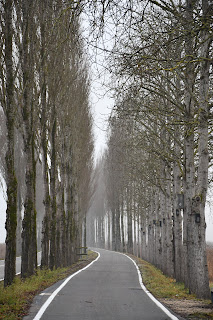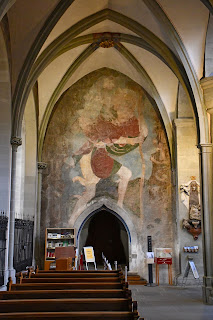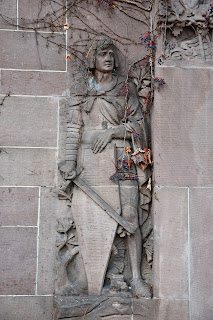Reichenau, Konstanz, and St. Gallen
With Christmas just around the corner, this weekend was my last opportunity to see Switzerland in its holiday glory. I decided to spend it in the German part of the country, booking a capsule at a cheap hostel in Zürich for two nights and arriving on Friday evening.
I woke up very early
on Saturday, as capsule hotels are not particularly conducive to sleep. When I
couldn’t hear people walking in and out, there was always someone’s snoring or
tossing and turning to keep me up. Leaving the hostel before six, I arrived at
the train station with only a few minutes to buy a ticket and hop on the
earliest train to Konstanz (the next one left an hour later). Indeed, time was
so scant that I did not even manage to buy breakfast at the station and rode
grumpily all the way to Germany.
I arrived in Konstanz
after daybreak, but the sky was still grey and unwelcoming. Although good
weather had been forecasted for the weekend, the immense Bodensee shrouded the
entire area in a thick layer of mist. Instead of walking around Konstanz,
therefore, I figured I would kill a little more time by buying breakfast and
continuing to Reichenau – an island known for its long monastic history.
Despite the modern causeway connecting the island with the mainland, the train
does not run directly from Konstanz to Reichenau but stops in Reichenau Baden.
From thence, one can either take the hourly bus or walk for about an hour to
the first point of interest. Since it was cold and the fog still hadn’t lifted,
I decided to walk.
There is something
about crossing a misty landscape (especially in the proximity of a medieval
monastic island) that makes one feel unmoored in time and space. I felt as
though, at any moment, I might see a monk row his little wooden boat into the field
of reeds, which shielded the narrow causeway from the vast emptiness beyond.
Almost equally haunting, what I really saw was a swan counterposing its
whiteness against the whiteness of the fog, and a flock of black ducks so still
that I thought they were rocks. My presence also spooked a bird of prey, which swooped
down with a strange slowness as soon as I drew near.
The fog had not lifted
by the time I reached my first destination, the Church of Saint George. It was
closed, and waiting for it to open would have been pointless: a notice by the
door said it only opened to guided tours in summer months. After taking a few
pictures of the exterior, therefore, I continued towards the centre of the
island, which houses the Monastery of Saints Mary and Mark. This monastery, for
a change, turned out to be open. There were a few large stone-carvings of
former bishops and an interesting depiction of the Last Supper, but the most impressive
part was the finely decorated ceiling above the altar.
I decided not to
continue my walk along the island, as it did not seem all that interesting. Despite
its medieval fame, the landscape of modern Reichenau is typified by the same
houses as can be found anywhere else in Germany, which means that in the fog
there really isn’t very much to look at. Once I had checked the bus schedule
for the third or fourth time, it occurred to me that the bus driver might only
accept cash for tickets. I was relieved to find an ATM close by with the help
of Google Maps.
While there weren’t
too many people on the bus from the island, the train back to Konstanz was
completely packed. Apparently, everyone had taken it in their head to see the
Christmas market, and rather than wait for a sensible time, they all decided upon
late morning. The market was set up just north of the train station by the
lake. I made a little excursion of the area, taking in the view of the majestic
wooden Council Building from the quay. Afterwards, I headed towards the centre
to see the Emperor’s Fountain.
I do not know what is
wrong with me, but as of late, listening to music has frequently made my cry. I
received some change when I bought my bus ticket and gave a coin to a street
musician playing Vivaldi’s Winter on accordion; I hoped that the gesture
entitled me to standing by awkwardly with tears rolling down my face. My eyes
got a bit wet again as I heard a brass band performing Christmas songs in front
of the Emperor’s Fountain, and once more when I heard a violinist intoning
Schubert’s Ave Maria in front of the Monastery of Our Beloved Lady.
I found the Monastery
very impressive. I walked in from the side entrance and was immediately greeted
by a massive fresco, after which the ornate organ came into view above the main
door. From the altar and the pulpit to the paintings all around, every piece
was a true work of art. Walking down into what I thought was the crypt, I found
a brightly coloured chapel with a golden reliquary, as well as what seemed to
be an older, more mysterious chapel with hefty pillars. The subterranean
portion led another section of the monastery, and following the path I realised
that the complex was much bigger than I had assumed: I emerged into the
cloisters, where several more chapels awaited.
From the Monastery, I
continued north until I reached the Rhine, which is guarded by a quaint tower
with a red roof. Appropriately, it is named the Rhine Gate Tower. To the west
of this tower is the Powder Tower, and a short journey south along the main
road stands the monument to Jan Hus. Erected in honour of the Czech reformer
and critic of clerical corruption, it takes the shape of a chalice, which
symbolises the idea that all worshippers are entitled to drink the wine of the
communion. After Hus’s martyrdom in Konstanz – which in Czech is referred to as
Kostnice, meaning “bonehouse” – the chalice became the main symbol of
the Hussites. Hus’s execution (and that of his disciple Hieronymus of Prague)
is symbolised on the statue by stylised flames.
From the monument, I
continued to the southwestern corner of the old town, which is demarked by the
Schnetztor – an imposing tower-gate that used to guard against the south but
now overlooks a major intersection. The gate is well visible from the Jan Hus
Museum, which is housed in the building where Hus awaited his trial and
subsequent death. Finally, I walked back to the train station and since I still
had some time to kill until the next train, I decided to lunch on käsespätzle
at the Christmas market.
For my third and final
destination I visited St. Gallen, a town in the far east of Switzerland. Its
main attractions are religious: after viewing the almost moorishly colourful
Saint Lawrence Church, one cannot leave out the Monastery of Saint Gall. The
monastery’s focal point is its cathedral, whose interior boasts a panorama of
massive ceiling paintings, as well as many baroque details. Equally if not more
impressive, however, is Saint Gall’s famed library, which bears similarly
themed decorations.
Since the library tickets are an expensive three for one deal, I visited the two other exhibitions at the monastery as well: the cellars, which house many sacred objects and precious manuscripts, and the archive, where one can see writings more than a millennium old. I reached the latter a little before three o’clock, and I was told at the reception that there would be a guided tour of another wing at the monastery. I am not usually a fan of guided tours, but I was lured in by the promise that I would see a place that is usually off limits to tourists. The tour lived up to this selling point. As I learned, the prohibited wing houses all the offices and meeting areas of the canton’s governing body, including the parliamentary hall, the meeting room of the canton’s council, and the dining room.
Besides the obligatory explanations of the building’s history, the guide also sprinkled in a number of fun titbits. For example, the buttons used to vote “yes” or “no” during parliamentary sessions do not work by themselves. In fact, a member has to press their choice simultaneously with another button on the other side of the table. This mechanism was implemented after one member of parliament pressed the button for an absent colleague, generating public outcry despite his assurances that he voted the way his colleague would have wanted. The guide also explained that although minutes are now taken with the help of an automatic transcription system, some representatives have such thick regional accents that considerable human assistance is still needed.









































































Comments
Post a Comment